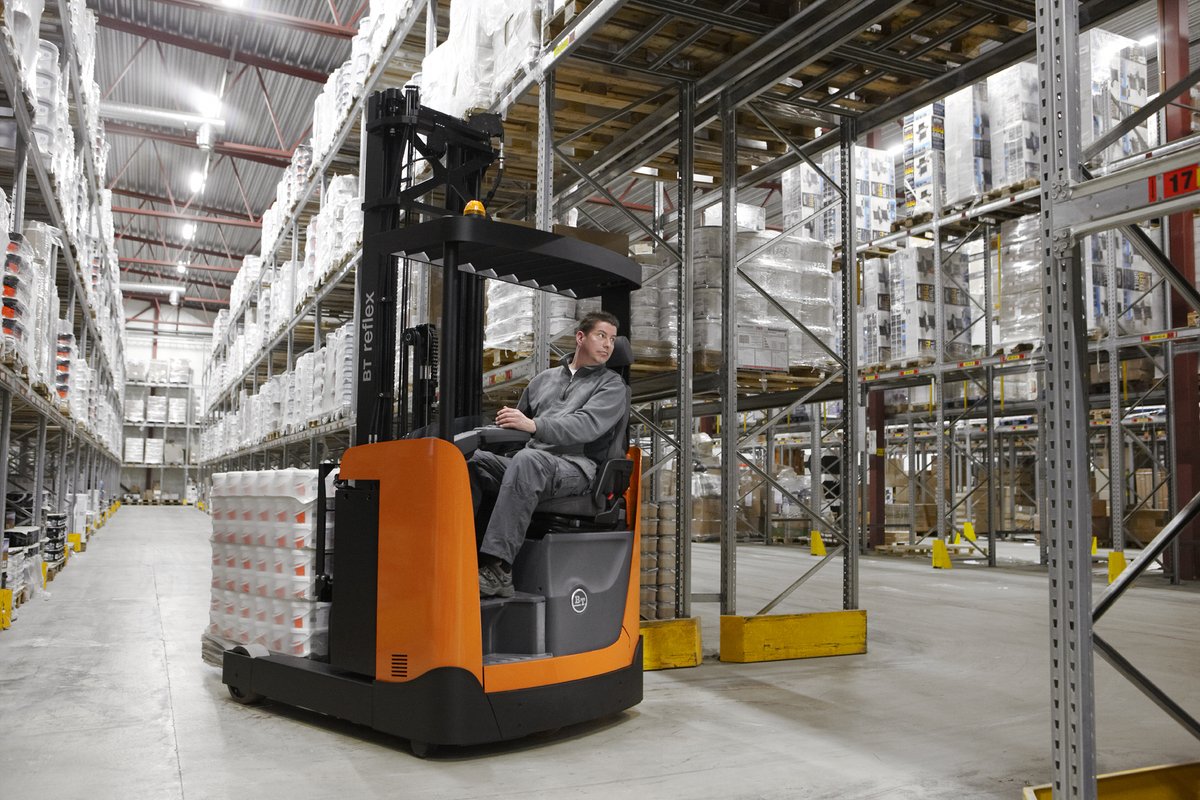
Forklifts are highly useful machines used for moving heavy loads from one place to another, particularly in construction and warehouse settings. With a wide variety of types available, choosing the right forklift often depends on the specific application and the load to be moved. We detailed this topic in our article "Things to Consider for Choosing the Right Forklift". In today's article, we will briefly touch on what a Reach Truck is and explain its operating principles.
What is a Reach Truck?
Let's start with a brief definition of a reach truck.
Reach trucks, also known as side loaders, are portable, electrically powered forklifts designed for use in narrow aisles and tight spaces. Due to their design, which features a smaller turning radius, reach truck operators can navigate small and narrow spaces, and lift and place loads from high places, making reach trucks a preferred choice. They can also distribute loads rather than focusing on one direction, allowing them to carry relatively heavier loads. They are highly beneficial machines for saving space and time.
Reach Truck Design
With two outer legs to distribute the load evenly across the entire machine, reach trucks are designed with a single set of wheels at the back, under the operator. The load handling mechanism is located on the side, and the short turning radius design allows for high maneuverability in tight and small spaces, which is the main design goal.
How Does a Reach Truck Work?
All forklifts operate on the same basic principles, and reach trucks (side loaders) are no different. The question we seek to answer here is, "What are the operating principles of a forklift?"
To answer this, we need to know all the components of a forklift and their functions. Let's first get to know the components and mechanisms that enable a forklift to operate, and then explain the operating principles of these machines.
Forklift mechanisms and their components can be broadly categorized into two main groups:
- Lifting Mechanisms
- Control Mechanisms
Lifting Mechanisms
Since the primary purpose of forklifts is to lift and transport loads, lifting mechanisms are crucial to their operating principles. Hydraulic cylinders and roller chain pulleys are the components that make up the lifting mechanism.
Control Mechanisms
Control mechanisms are added to the forklift to enable the operator to control the machine. There are two different control mechanisms: one for steering and one for controlling the spring-loaded lift.
Components
Chassis (Truck Frame): This is the structure to which all components of the forklift are attached. It is the fundamental element of the machine.
Counterweight: To balance the load being carried, a counterweight is placed opposite the lifting mechanism. In reach trucks, this weight is integrated with the battery.
Electric Motor: Reach trucks are powered by electric motors. While other forklifts may use internal combustion engines (see "Differences Between Electric Forklifts and Diesel Forklifts"), reach trucks are primarily powered by an electric motor.
Load Handling Equipment: The equipment that enables the forklift to perform its primary function is called the load handling equipment. It is attached to the mast rails and moves the load up and down.
Mast: The mast, made up of interlocking rails that provide direct control, supports the load handling equipment. It moves loads up and down and can be supported by rollers.
Hydraulic Components: These include the hydraulic reservoir, connectors, control valves, and cylinders within the machine. Hydraulic components are critical for the proper functioning of the forklift, and their maintenance should not be neglected.
How Does a Reach Truck Work?
As previously mentioned, the basic operating principles of reach trucks are the same as those of other forklifts. The minor differences will be explained throughout the article.
The most crucial detail for proper operation is load balancing. The balance of the load is maintained by the counterweight and the pivot point of the forklift. Improper load balancing can result in the inability to carry the load or even the tipping of the forklift, posing significant danger to the operator and workers. It operates on a principle similar to a seesaw. Therefore, maintaining balance and not exceeding the load capacity of the vehicle is vital.
The second principle in the operation of forklifts is the balance of the machine. Ensuring the forklift is balanced and the weight distribution is maintained is crucial for load handling. Balance in forklifts is maintained by the pivot points, also known as the stabilizers. Reach trucks use a three-point stability system, with two legs and rear wheels providing balance. Improper balancing can damage both the machine and the load, posing a significant risk.
Another important factor in load balancing is the weight between the front wheels of the machine and the operator. This weight helps balance the load, while the front wheels act as the fulcrum point.
Lifting is achieved through hydraulic cylinders and roller chain pulleys. The operator controls the load handling equipment, which moves using the mast and rollers. This allows the load to be moved from one place to another. The load capacity varies depending on the size, design, and type of the forklift. They can be maneuvered within their turning radius using the control mechanism and spring-loaded steering mechanism.
In this article, we have covered what reach trucks are, their internal mechanisms, components, and operating principles. If you are looking for a reach truck (side loader) for your warehouse or work area, MachineGo is here for you! If you want to rent the most suitable reach truck for your job, click "here".



